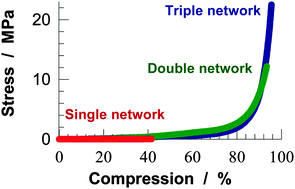Mechanically strong triple network hydrogels based on hyaluronan and poly(N,N-dimethylacrylamide)†
Abstract
Hyaluronan (HA) is a natural polyelectrolyte with distinctive biological functions. Cross-linking of HA to generate less degradable hydrogels for use in biomedical applications has attracted interest over many years. One limitation of HA hydrogels is that they are very brittle and/or easily dissolve in physiological environments, which limit their use in load-bearing applications. Herein, we describe the preparation of triple-network (TN) hydrogels based on HA and poly(N,N-dimethylacrylamide) (PDMA) of high mechanical strength by sequential gelation reactions. TN hydrogels containing 81–91% water sustain compressive stresses above 20 MPa and exhibit Young's moduli of up to 1 MPa. HA of various degrees of methacrylation was used as a multifunctional macromer for the synthesis of the brittle first-network component, while loosely cross-linked PDMA was used as the ductile, second and third network components of TN hydrogels. By tuning the methacrylation degree of HA, double-network hydrogels with a fracture stress above 10 MPa and a fracture strain of 96% were obtained. Increasing the ratio of ductile-to-brittle components via the TN approach further increases the fracture stress above 20 MPa. Cyclic mechanical tests show that, although TN hydrogels internally fracture even under small strain, the ductile components hinder macroscopic crack propagation by keeping the macroscopic gel samples together.


 Please wait while we load your content...
Please wait while we load your content...